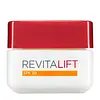What's inside
What's inside
 Key Ingredients
Key Ingredients

 Benefits
Benefits

 Concerns
Concerns

 Ingredients Side-by-side
Ingredients Side-by-side

Water
Skin ConditioningGlycerin
HumectantEthylhexyl Salicylate
UV AbsorberDimethicone
EmollientAlcohol Denat.
AntimicrobialOctocrylene
UV AbsorberNylon-12
Butyl Methoxydibenzoylmethane
UV AbsorberOctyldodecanol
EmollientPhenylbenzimidazole Sulfonic Acid
UV AbsorberCetyl Alcohol
EmollientBehenyl Alcohol
EmollientTriethanolamine
BufferingIsopropyl Isostearate
EmollientHydrolyzed Soy Protein
HumectantAcetyl Trifluoromethylphenyl Valylglycine
Skin ConditioningAdenosine
Skin ConditioningCapryloyl Salicylic Acid
ExfoliatingDisodium EDTA
Faex Extract
Skin ConditioningSalicyloyl Phytosphingosine
Skin ConditioningRetinyl Palmitate
Skin ConditioningAcrylamide/Sodium Acryloyldimethyltaurate Copolymer
Emulsion StabilisingAluminum Starch Octenylsuccinate
AbsorbentAmmonium Polyacryloyldimethyl Taurate
Emulsion StabilisingCetearyl Alcohol
EmollientCetearyl Glucoside
EmulsifyingDisodium Stearoyl Glutamate
CleansingHydroxyethyl Acrylate/Sodium Acryloyldimethyl Taurate Copolymer
Emulsion StabilisingIsohexadecane
EmollientMyristic Acid
CleansingPalmitic Acid
EmollientPEG-100 Stearate
Pentylene Glycol
Skin ConditioningPoly C10-30 Alkyl Acrylate
Emulsion StabilisingPolyethylene
AbrasivePolysorbate 60
EmulsifyingPolysorbate 80
EmulsifyingSorbitan Isostearate
EmulsifyingSorbitan Oleate
EmulsifyingStearic Acid
CleansingSilica
AbrasiveTitanium Dioxide
Cosmetic ColorantAlpha-Isomethyl Ionone
PerfumingBenzyl Alcohol
PerfumingBenzyl Salicylate
PerfumingCitronellol
PerfumingGeraniol
PerfumingHexyl Cinnamal
PerfumingLimonene
PerfumingLinalool
PerfumingCI 15510
Cosmetic ColorantPhenoxyethanol
PreservativeTocopherol
AntioxidantParfum
MaskingWater, Glycerin, Ethylhexyl Salicylate, Dimethicone, Alcohol Denat., Octocrylene, Nylon-12, Butyl Methoxydibenzoylmethane, Octyldodecanol, Phenylbenzimidazole Sulfonic Acid, Cetyl Alcohol, Behenyl Alcohol, Triethanolamine, Isopropyl Isostearate, Hydrolyzed Soy Protein, Acetyl Trifluoromethylphenyl Valylglycine, Adenosine, Capryloyl Salicylic Acid, Disodium EDTA, Faex Extract, Salicyloyl Phytosphingosine, Retinyl Palmitate, Acrylamide/Sodium Acryloyldimethyltaurate Copolymer, Aluminum Starch Octenylsuccinate, Ammonium Polyacryloyldimethyl Taurate, Cetearyl Alcohol, Cetearyl Glucoside, Disodium Stearoyl Glutamate, Hydroxyethyl Acrylate/Sodium Acryloyldimethyl Taurate Copolymer, Isohexadecane, Myristic Acid, Palmitic Acid, PEG-100 Stearate, Pentylene Glycol, Poly C10-30 Alkyl Acrylate, Polyethylene, Polysorbate 60, Polysorbate 80, Sorbitan Isostearate, Sorbitan Oleate, Stearic Acid, Silica, Titanium Dioxide, Alpha-Isomethyl Ionone, Benzyl Alcohol, Benzyl Salicylate, Citronellol, Geraniol, Hexyl Cinnamal, Limonene, Linalool, CI 15510, Phenoxyethanol, Tocopherol, Parfum
Water
Skin ConditioningGlycerin
HumectantNiacinamide
SmoothingEthylhexyl Olivate
Skin ConditioningPassiflora Edulis Seed Oil
EmollientGlyceryl Stearate Se
EmulsifyingBorago Officinalis Seed Oil
EmollientSclerocarya Birrea Seed Oil
HumectantCetearyl Alcohol
EmollientCeteareth-20
CleansingSqualane
EmollientBisabolol
MaskingButyrospermum Parkii Butter
Skin ConditioningTasmannia Lanceolata Fruit/Leaf Extract
AntioxidantSodium PCA
HumectantUrea
BufferingTrehalose
HumectantHexylene Glycol
EmulsifyingPolyquaternium-51
Skin ConditioningTriacetin
AntimicrobialCaprylyl Glycol
EmollientAscorbyl Palmitate
AntioxidantAcrylates/C10-30 Alkyl Acrylate Crosspolymer
Emulsion StabilisingSodium Phytate
Cellulose Gum
Emulsion StabilisingAlgin
MaskingSodium Hyaluronate
HumectantTocopherol
AntioxidantMethylpropanediol
SolventPhenoxyethanol
PreservativeAlcohol
AntimicrobialSodium Hydroxide
BufferingFarnesol
PerfumingWater, Glycerin, Niacinamide, Ethylhexyl Olivate, Passiflora Edulis Seed Oil, Glyceryl Stearate Se, Borago Officinalis Seed Oil, Sclerocarya Birrea Seed Oil, Cetearyl Alcohol, Ceteareth-20, Squalane, Bisabolol, Butyrospermum Parkii Butter, Tasmannia Lanceolata Fruit/Leaf Extract, Sodium PCA, Urea, Trehalose, Hexylene Glycol, Polyquaternium-51, Triacetin, Caprylyl Glycol, Ascorbyl Palmitate, Acrylates/C10-30 Alkyl Acrylate Crosspolymer, Sodium Phytate, Cellulose Gum, Algin, Sodium Hyaluronate, Tocopherol, Methylpropanediol, Phenoxyethanol, Alcohol, Sodium Hydroxide, Farnesol
Ingredients Explained
These ingredients are found in both products.
Ingredients higher up in an ingredient list are typically present in a larger amount.
Cetearyl alcohol is a mixture of two fatty alcohols: cetyl alcohol and stearyl alcohol. It is mainly used as an emulsifier. Emulsifiers help prevent the separation of oils and products. Due to its composition, it can also be used to thicken a product or help create foam.
Cetearyl alcohol is an emollient. Emollients help soothe and hydrate the skin by trapping moisture.
Studies show Cetearyl alcohol is non-toxic and non-irritating. The FDA allows products labeled "alcohol-free" to have fatty alcohols.
This ingredient is usually derived from plant oils such as palm, vegetable, or coconut oils. There is debate on whether this ingredient will cause acne.
Due to the fatty acid base, this ingredient may not be Malassezia folliculitis safe.
Learn more about Cetearyl AlcoholGlycerin is already naturally found in your skin. It helps moisturize and protect your skin.
A study from 2016 found glycerin to be more effective as a humectant than AHAs and hyaluronic acid.
As a humectant, it helps the skin stay hydrated by pulling moisture to your skin. The low molecular weight of glycerin allows it to pull moisture into the deeper layers of your skin.
Hydrated skin improves your skin barrier; Your skin barrier helps protect against irritants and bacteria.
Glycerin has also been found to have antimicrobial and antiviral properties. Due to these properties, glycerin is often used in wound and burn treatments.
In cosmetics, glycerin is usually derived from plants such as soybean or palm. However, it can also be sourced from animals, such as tallow or animal fat.
This ingredient is organic, colorless, odorless, and non-toxic.
Glycerin is the name for this ingredient in American English. British English uses Glycerol/Glycerine.
Learn more about GlycerinPhenoxyethanol is a preservative that has germicide, antimicrobial, and aromatic properties. Studies show that phenoxyethanol can prevent microbial growth. By itself, it has a scent that is similar to that of a rose.
It's often used in formulations along with Caprylyl Glycol to preserve the shelf life of products.
Tocopherol (also known as Vitamin E) is a common antioxidant used to help protect the skin from free-radicals and strengthen the skin barrier. It's also fat soluble - this means our skin is great at absorbing it.
Vitamin E also helps keep your natural skin lipids healthy. Your lipid skin barrier naturally consists of lipids, ceramides, and fatty acids. Vitamin E offers extra protection for your skin’s lipid barrier, keeping your skin healthy and nourished.
Another benefit is a bit of UV protection. Vitamin E helps reduce the damage caused by UVB rays. (It should not replace your sunscreen). Combining it with Vitamin C can decrease sunburned cells and hyperpigmentation after UV exposure.
You might have noticed Vitamin E + C often paired together. This is because it is great at stabilizing Vitamin C. Using the two together helps increase the effectiveness of both ingredients.
There are often claims that Vitamin E can reduce/prevent scarring, but these claims haven't been confirmed by scientific research.
Learn more about TocopherolWater. It's the most common cosmetic ingredient of all. You'll usually see it at the top of ingredient lists, meaning that it makes up the largest part of the product.
So why is it so popular? Water most often acts as a solvent - this means that it helps dissolve other ingredients into the formulation.
You'll also recognize water as that liquid we all need to stay alive. If you see this, drink a glass of water. Stay hydrated!
Learn more about Water